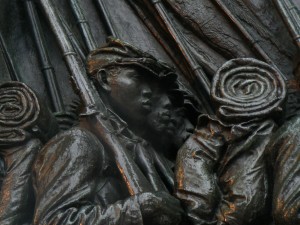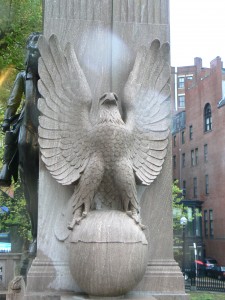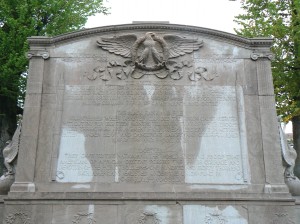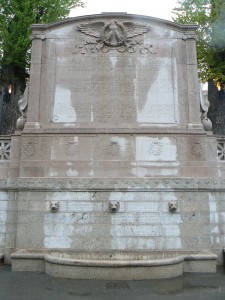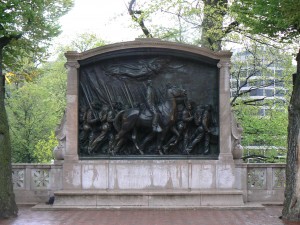 Massachusetts honors a largely African American Civil War regiment with a notable Saint-Gaudens monument on Boston Common.
Massachusetts honors a largely African American Civil War regiment with a notable Saint-Gaudens monument on Boston Common.
The Robert Gould Shaw Memorial, dedicated in 1897 near the corner of Beacon and Park streets, honors Shaw and the members of the 54th Massachusetts Volunteer Infantry Regiment. The unit blended white officers with African American troops recruited from several states and Canada.
Shaw and other members of the 54th died during an assault on Fort Wagner, which stood near Charleston, S.C.
The front (north) face of the monument features a large bas-relief illustrating the regiment’s departure from Boston on May 28, 1863. Shaw, the regiment’s commander, is depicted on horseback while the regiment, guided by an angel, marches alongside him.
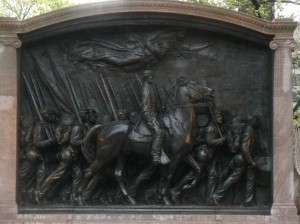 Under the relief, a dedication reads, “Robert Gould Shaw. Colonel of the Fifty Fourth Regiment of Massachusetts Infantry. Born in Boston 10 October MDCCCXXXVII (1837). Killed while leading the assault on Fort Wagner, South Carolina, 18 July MDCCCLXIII (1863).
Under the relief, a dedication reads, “Robert Gould Shaw. Colonel of the Fifty Fourth Regiment of Massachusetts Infantry. Born in Boston 10 October MDCCCXXXVII (1837). Killed while leading the assault on Fort Wagner, South Carolina, 18 July MDCCCLXIII (1863).
Under the dedication is a verse from a poem, “Memoriae Positum,” by James Russell Lowell.
The monument also features two large eagles on its east and west sides. Modern-era granite markers on the site provide information about the monument and its sculptor.
On the south side of the monument, a lengthy dedication by Harvard president Charles W. Eliot provides information about the regiment and praises its African American soldiers for having the “pride, courage and devotion of the patriot soldier.”
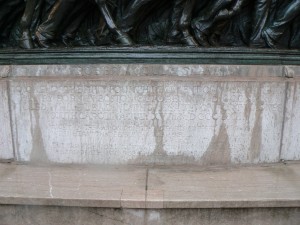 The names of five regimental officers killed in the war (two during the Fort Wagner assault) are inscribed on the monument and surrounded by wreaths. The names of 62 soldiers killed in the Fort Wagner assault were added to the monument’s south face during a 1982 restoration.
The names of five regimental officers killed in the war (two during the Fort Wagner assault) are inscribed on the monument and surrounded by wreaths. The names of 62 soldiers killed in the Fort Wagner assault were added to the monument’s south face during a 1982 restoration.
The monument was created by noted sculptor Augustus Saint-Gaudens, whose other famous works include a standing Lincoln statue in Chicago as well as statues of Union general William T. Sherman and Admiral David Farragut in New York.
The regiment, which had trained outside the city, passed by the monument’s location during their march to the Boston Harbor ships that would take them south. The unit’s route passed the Massachusetts state house (across from the monument) and the Shaw family home at 44 Beacon Street. Shaw raised his sword as he passed the home.
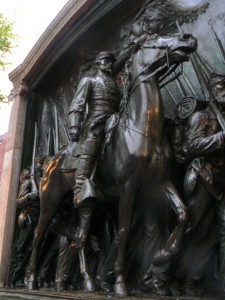 After the fighting at Fort Wagner, the Confederates buried Shaw and his troops in a common grave, a move that defied the honorable treatment traditionally provided to deceased officers. Shaw’s family declined later offers to have him exhumed, saying they were honored that he was buried with his troops.
After the fighting at Fort Wagner, the Confederates buried Shaw and his troops in a common grave, a move that defied the honorable treatment traditionally provided to deceased officers. Shaw’s family declined later offers to have him exhumed, saying they were honored that he was buried with his troops.
Tags: Massachusetts
